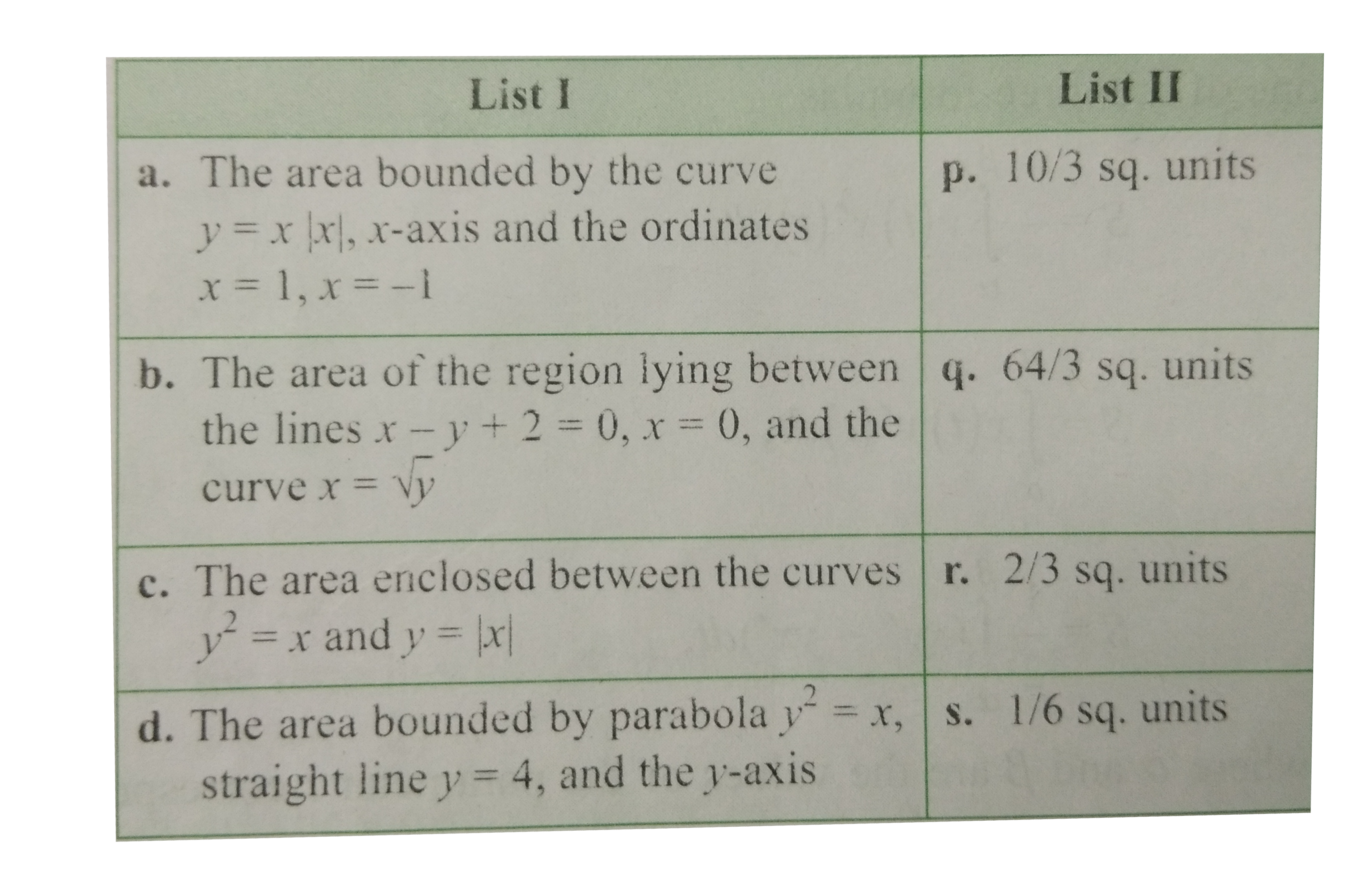Let Ar be the area of the region bounded between the curves y2=(e−kr)x(where k>0,r∈N) and the line y=mx(where m≠0), k and m are some constants
A1,A2,A3,… are in G.P. with common ratio Solution in Bengali
e−k
e−2k
e−4k
None of these
The correct Answer is:B
Solving the two equations, we get
m2x2=(e−kr)x
x1=0,x2=e−krm2.

So, Ar=x2∫0(e−kr2√x−mx)dx
=23e−kr/2x3/22−mx222
=23e−kr/2e−3kr/2m3−m2e−2krm4=e−2kr6m3.
Now, Ar+1Ar=e−2k(r+1)e−2kr=e−2k=constant.
So, the sequence A1,A2,A3,... is in G.P.
Sum of n terms =e−2k6m3e−2nk−1e−2k−1=16m3e−2nk−11−e2k
Sum to infinte terms =A111−e−2k
=e−2k6m3×e2ke2k−1=16m3(e2k−1).
Topper's Solved these Questions
- BOOK - CENGAGE PUBLICATIONCHAPTER - AREAEXERCISE - Matrix Match Type5videos
AREA
- BOOK - CENGAGE PUBLICATIONCHAPTER - AREAEXERCISE - Numerical Value Type18videos
AREA
- BOOK - CENGAGE PUBLICATIONCHAPTER - AREAEXERCISE - Multiple Correct Answers Type13videos
AREA
- BOOK - CENGAGE PUBLICATIONCHAPTER - APPLICATIONS OF DERIVATIVESEXERCISE - Subjective Type2videos
APPLICATIONS OF DERIVATIVES
- BOOK - CENGAGE PUBLICATIONCHAPTER - BINOMIAL THEOREMEXERCISE - Comprehension11videos
BINOMIAL THEOREM
Similar Questions
Match the following lists :
 01:36View Solution
01:36View SolutionThe area enclosed by the curve c:y=x√9−x2(x≥0) and the x-axis is________
View SolutionLet A(k) be the area bounded by the curves y=x2−3 and y=kx+2 The range of A(k) is (10√53,∞) The range of A(k) is (20√53,∞) If function k→A(k) is defined for k∈[−2,∞ ), then A(k) is many-one function. The value of k for which area is minimum is 1.
10:02View SolutionProve that for λ>1, the equation xlogx+x=λ has least one solution in [1,λ].
10:13View SolutionConsider a G.P. with first term (1+x)n, |x|<1, common ratio 1+x2 and number of terms (n+1). Let 'S' be sum of all the terms of the G.P., then
The coefficient of xn is 'S' is12:23View SolutionLet (1+x+x^(2))^(n)=sum_(r=0)^(2n)a_(r)*x^(r), where n is a positive integer,if we have a_(0)+a_(1)+a_(2)+.........+a_(n-1)=(3^(n)-a_(n))(2k) ,then the value of k isn 2n
05:16View SolutionLet a1,a2,a3,…,a10 be in G.P. with ai>0 for i=1, 2, …, 10 and S be te set of pairs (r, k), r, k ∈ N (the set of natural numbers)
for which ∣∣ ∣ ∣∣logear1ak2logear2ak3logear3ak4logear4ak5logear5ak6logear6ak7logear7ak8logear8ak9logear9ak10∣∣ ∣ ∣∣ = 0. Then the number of elements in S isView SolutionLet Ar be the area of the region bounded between the curves y2=(e−kr)x(where k>0,r∈N) and the line y=mx(where m≠0), k and m are some constants
A1,A2,A3,… are in G.P. with common ratio12:00View SolutionLet Ar be the area of the region bounded between the curves y2=(e−kr)x(where k>0,r∈N) and the line y=mx(where m≠0), k and m are some constants
limn→∞Σni=1Ai=148(e2k−1) then the value of m is01:29View SolutionLet a1,a2,a3……,a10 be in GP with ai> for I=2,2,…..,10 and S be the set of pairs (r,k), r,k∈N (the set of natural numbers) for which
⎡⎢ ⎢⎣logear1ak2logear2ak3logear3ak4logear4ak5logear5ak6logear6ak7logear7ak8logear8ak9logear9ak10⎤⎥ ⎥⎦=0 ltbgt Then the number of elements is S, is05:35View SolutionIf aa,a2,a3,….,an are in H.P. and f(k)=n∑r=1ar−ak, then a1f(1),a2f(2),....a3f(n) are in :
10:43View SolutionLet a1,a2,a3 …. an be in G.P. If the area bounded by the curve y2=4anX and y2=4an(an−x) be An, then the sequence A1,A2,A3…….An are in
13:48View SolutionLet the straight line y=k divide the area enclosed by x=(1−y)2 , x=0 and y=0 into two parts of areas, A1(0≤y≤k) and A2(k≤y≤1) such that A1A2=7. Then 1k is equal to
08:26View SolutionIf a1,a2,a3,.... are in G.P. with common ratio as r2 then loga1,loga2,loga3,.... will be in
04:39View SolutionLet a1,a2,a3,…,a10 be in G.P. with ai>0 for i=1, 2, …, 10 and S be te set of pairs (r, k), r, k ∈ N (the set of natural numbers)
for which ∣∣ ∣ ∣∣logear1ak2logear2ak3logear3ak4logear4ak5logear5ak6logear6ak7logear7ak8logear8ak9logear9ak10∣∣ ∣ ∣∣ = 0. Then the number of elements in S is13:34View SolutionLet Ar be the area of the region bounded between the curves y2=(e−kr)x(where k>0,r∈N) and the line y=mx(where m≠0), k and m are some constants
A1,A2,A3,… are in G.P. with common ratio09:31View Solution

